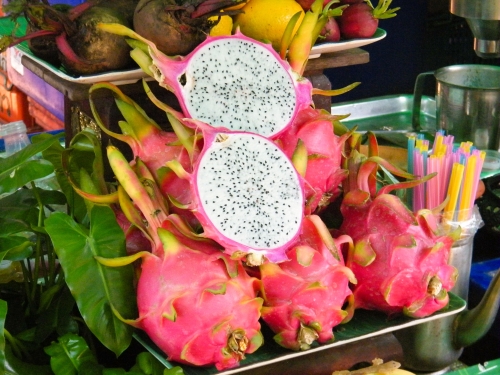
What Is Dragon Fruit and Does It Have Health Benefits?
Dragon fruit is a tropical fruit that’s low in calories and high in fiber and antioxidants. Some people say it tastes like a cross between a pear and a kiwi. You can slice and eat the fruit as-is, try it with yogurt, or add it to a smoothie or salad.
Dragon fruit is a tropical fruit that has become increasingly popular in recent years.
Though people primarily enjoy it for its unique look and taste, evidence suggests it may provide health benefits as well.

What is dragon fruit?
Dragon fruit grows on the Hylocereus cactus, also known as the Honolulu queen, whose flowers only open at night.
The plant is native to southern Mexico and Central America. Today, it is grown all over the world.
It goes by many names, including pitaya, pitahaya, and strawberry pear.
The two most common types have bright red skin with green scales that resemble a dragon — hence the name.
The most widely available variety has white pulp with black seeds, though a less common type with red pulp and black seeds exists as well.
Another variety — referred to as yellow dragon fruit — has yellow skin and white pulp with black seeds.
Dragon fruit may look exotic, but its flavors are similar to other fruits. Its taste has been described as a slightly sweet cross between a kiwi and a pear.
Nutrition Facts
Dragon fruit contains small amounts of several nutrients. It’s also a decent source of iron, magnesium, and fiber.
Here are the nutrition facts for a serving of 3.5 ounces, or 100 grams (1Trusted Source):
- Calories: 57
- Protein: 0.36 grams
- Fat: 0.14 grams
- Carbs: 15 grams
- Fiber: 3 grams
- Vitamin C: 5% of the DV
- Iron: 1% of the DV
- Magnesium: 2% of the DV
Provides several antioxidants
Dragon fruit contains several types of antioxidants.
These are compounds that protect your cells from unstable molecules called free radicals, which are linked to chronic diseases and aging (2Trusted Source).
These are some of the main antioxidants contained in dragon fruit pulp (3):
- Betalains: Found in the pulp of red dragon fruit, these deep red pigments have been shown to significantly reduce total cholesterol, LDL, and other health risk factor markers (4Trusted Source).
- Hydroxycinnamates: This group of compounds has demonstrated anticancer activity in test-tube and animal studies (5Trusted Source).
- Flavonoids: This large, diverse group of antioxidants is linked to better brain health and a reduced risk of heart disease (6Trusted Source, 7).
While dragon fruit’s antioxidant capacity was not especially high, it was found to be best at protecting certain fatty acids from free radical damage (8Trusted Source)